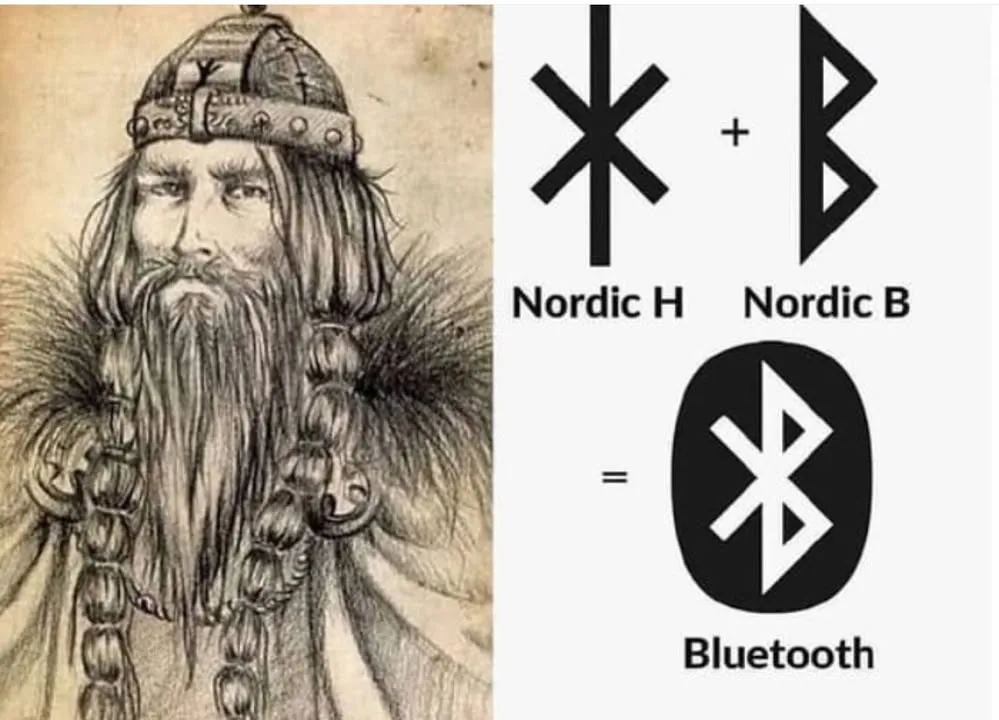Bluetooth: A Modern Technology with Viking Roots
Bluetooth technology, a wireless standard that connects devices like smartphones, headphones, and keyboards, carries a name steeped in Viking history. Named after Harald Bluetooth, a 10th-century Scandinavian king, the technology reflects his legacy of unification, while its iconic logo and nickname add layers of intrigue. Below, we explore the origins of Bluetooth’s name, its connection to Harald, and the myths behind his colorful moniker.
Harald Bluetooth: The Viking Unifier
Harald “Bluetooth” Gormsson (c. 910–985/986 CE) was a Danish king credited with unifying disparate Danish tribes and integrating parts of Norway under his rule, as well as converting Scandinavia to Christianity. His reign, roughly from 958 to 986 CE, marked a pivotal moment in Nordic history, consolidating power and fostering cultural cohesion.
Unification: Harald inherited the Danish throne from his father, Gorm the Old, and expanded his influence by subduing rival chieftains. The Jelling Stones, massive runestones in Denmark, proclaim his achievements, with one erected by Harald declaring that he “won for himself all of Denmark and Norway and made the Danes Christian.” While his control over Norway was temporary, his efforts laid the groundwork for a unified Scandinavian identity.
Christianity: Harald’s conversion to Christianity, likely around 965 CE, was partly strategic, aligning Denmark with powerful Christian neighbors like the Holy Roman Empire and reducing threats from German invasions. He built churches and promoted the faith, shifting Denmark from pagan traditions.
Legacy: Harald’s reign ended in conflict, possibly killed in a rebellion led by his son, Sweyn Forkbeard. His diplomatic and unifying efforts, however, earned him a lasting place in history.
Why “Bluetooth” for Technology?
In 1996, engineers from Intel, Ericsson, and Nokia collaborated to create a wireless communication standard to connect devices seamlessly. When naming the project, Jim Kardach, an Intel engineer, drew inspiration from Harald Bluetooth’s story, which he encountered while reading The Long Ships by Frans G. Bengtsson. Kardach saw a parallel: just as Harald unified Danish and Norwegian factions, the new technology would unify disparate devices—PCs, phones, and peripherals—into a cohesive network.
Temporary Codename: “Bluetooth” was initially a placeholder, chosen during a meeting over beers with Ericsson’s Sven Mattisson. Other names, like PAN (Personal Area Network) or RadioWire, were considered, but “Bluetooth” stuck due to its memorable and symbolic resonance.
Official Adoption: By 1998, the Bluetooth Special Interest Group (SIG) formalized the name, launching the technology with a nod to Viking heritage. The choice proved prescient, as Bluetooth became a global standard, now embedded in over 5 billion devices annually (2024 estimate).
The Bluetooth Logo: Nordic Runes
The iconic Bluetooth logo—a blue, stylized symbol resembling a slanted “B”—is a fusion of Nordic runes representing Harald’s initials, H and B, from the Younger Futhark alphabet used in Viking-era Scandinavia:
H (Hagall): ᚼ, a rune shaped like an “H” with slanted bars.
B (Bjarkan): ᛒ, resembling a “B” with angular loops.
Designed by the Bluetooth SIG, the logo merges these runes into a single glyph, symbolizing unity and connectivity. This nod to Harald’s legacy reinforces the technology’s Viking-inspired identity, delighting history buffs and tech enthusiasts alike. As one X post noted, “The Bluetooth logo is literally Viking runes—how cool is that?”
The Mystery of Harald’s Nickname
Harald’s sobriquet, “Bluetooth” (Blåtand in Old Norse, Blåtann in Danish), is a source of historical speculation, as no definitive record explains its origin. The nickname appears in medieval texts like the Heimskringla by Snorri Sturluson and the Chronicon Roskildense, written centuries after Harald’s death. Several theories attempt to decode it:
Blueberry Lover: A popular but apocryphal tale suggests Harald loved blueberries, which stained his teeth blue. This romantic notion, spread by modern storytelling, lacks historical evidence, as blueberries were not a staple in Viking diets, and dental staining from berries would be temporary. Historians dismiss this as a “cute but unlikely” myth.
Dead Tooth: A more plausible theory posits that Harald had a dead or decayed tooth, which could turn dark blue or gray due to nerve damage or infection. In Old Norse, blá could describe dark or blackish hues, not just bright blue. A prominent discolored tooth might have been a distinguishing feature, earning him the nickname. Dental health was poor in the Viking era, making this explanation credible, though unconfirmed.
Symbolic or Poetic: Some scholars suggest Blåtand was a kenning, a poetic metaphor common in Norse culture. It might refer to Harald’s eloquence (a “blue tongue” for diplomacy), his Christian faith (blue as a sacred color), or even a battle wound. Alternatively, it could derive from a misinterpretation of Blátonn (meaning “dark man” or “great man”), reflecting his stature or appearance.
Lost in Translation: The nickname might be a later invention by chroniclers, as medieval scribes often embellished rulers’ names. Without contemporary records, the true origin remains elusive.
No archaeological evidence, such as Harald’s remains, exists to confirm these theories, as his burial site (possibly at Roskilde Cathedral) is uncertain. The dead tooth hypothesis is favored by historians like Saxo Grammaticus’s modern interpreters, but the blueberry story persists in pop culture, amplified by tech blogs and X posts like, “Harald Bluetooth ate so many berries his teeth turned blue—wild!”
Then and Now: Harald’s Legacy in Technology
Harald Bluetooth’s unification of Scandinavian tribes mirrors Bluetooth technology’s role in connecting devices across industries:
Then: Harald bridged Danish and Norwegian factions, fostering trade and Christianity, with influence stretching to modern-day Sweden and parts of Germany.
Now: Bluetooth unifies over 36 billion devices (1998–2024), enabling wireless audio (AirPods, JBL speakers), IoT (smart locks, thermostats), and medical devices (glucose monitors). The Bluetooth 5.3 standard (2024) offers ranges up to 240 meters, data rates of 2 Mbps, and low-energy modes, powering innovations like Apple’s Find My network.
The technology’s evolution parallels Harald’s diplomatic legacy:

1998: Bluetooth 1.0 launched with a 10-meter range, connecting basic devices like headsets.
2010: Bluetooth 4.0 introduced Low Energy (BLE), revolutionizing wearables like Fitbit.
2024: Bluetooth supports mesh networks, spatial audio, and healthcare telemetry, with applications in smart cities and automotive systems (e.g., Tesla keyless entry).
Why the Name Matters
Naming Bluetooth after Harald was a stroke of marketing genius, blending history with innovation. The Viking king’s story resonates with the technology’s mission to “unify without wires,” as Kardach noted in a 2008 blog post. The logo’s runes add cultural depth, making Bluetooth more than a tech term—it’s a nod to human ingenuity across centuries. X users frequently highlight this, with one post joking, “Harald Bluetooth would be stoked to know his name powers my earbuds.”
The nickname debate—blueberries vs. dead tooth—adds playful intrigue, though the latter is more historically grounded. Regardless, Harald’s legacy endures, from the Jelling Stones to the Bluetooth SIG’s 40,000 member companies, including Apple, Samsung, and Sony.
Conclusion
Bluetooth technology’s name, inspired by Harald Bluetooth, celebrates a Viking king who united tribes over 1,000 years ago, much as the standard connects devices today. The Nordic rune logo, fusing Harald’s initials, H and B, embodies this unity, while his nickname—likely from a dead tooth, not blueberries—adds a human touch to his legend. From unifying Denmark and Norway to enabling wireless ecosystems, Harald’s influence spans millennia. As you pair your phone with a speaker, spare a thought for the Viking whose legacy powers our connected world—a true bridge between past and present.




